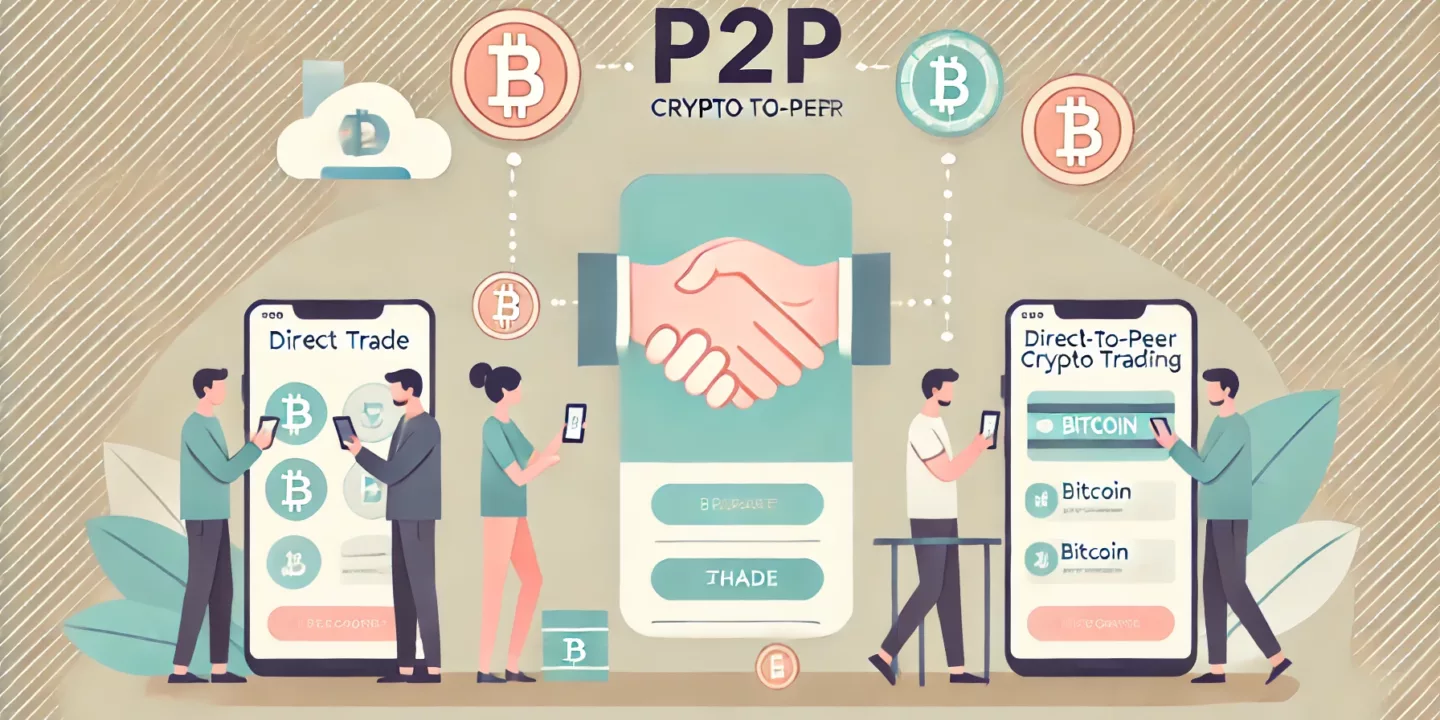
Crypto trading does not always need to be complex. You don’t have to master complex chart patterns or understand the intricacies of crypto exchanges. There is a simpler alternative in the market called peer-to-peer trading. Although not strictly regulated, more and more traders are shifting to it for many positive reasons.
What is Crypto Peer-to-Peer Trading?
Peer-to-peer (P2P) trading is a cryptocurrency exchange method that allows traders to trade directly without relying on a centralized third party.
In this trading, you, as a user, can select your preferred offers and deal directly with counterparties. Unlike traditional exchanges, which often have strict regulations and verification processes, P2P trading platforms are more relaxed regarding requirements.
How does P2P Crypto Trading Work?
P2P trading involves the following series of steps.
- Registration: Register yourself on a P2P crypto trading platform. Start by providing essential information and completing a verification process to ensure security and regulation compliance.
- Create a Listing: After registration, post a listing or ad indicating which cryptocurrency you want to buy or sell, how much, and the price you are looking for.
- Matching: The platform’s algorithm matches buyers and sellers based on their listings. This is usually done automatically. However, various platforms also allow manual searches to select their trading partners.
- Escrow Security: When the platform finds a match, the seller’s cryptocurrency is placed into an escrow account and remains there until the completion of the trade.
- Negotiation: Next, the buyer and seller can negotiate the terms of the trade. This might involve discussing payment methods, exchange rates, and other details.
- Confirmation and Execution: After both parties involved in the trade agree to the terms and conditions and confirm them, the buyer executes the transaction by making the agreed-upon payment. On the P2P crypto trading platform, payments are generally made through bank transfer or PayPal.
- Escrow Release: Once the seller receives the payment and confirms it, the escrow service will release the cryptocurrency to the buyer’s wallet.
- Feedback and Ratings: After the trade is completed, both sides can provide feedback on the overall trading experience and rate each other. This helps build community trust and makes future transactions easier to match.
P2P Crypto Trading Example
Let’s consider an example to illustrate this process:
Suppose you want to sell 1 Bitcoin (BTC) from your portfolio. Meanwhile, your friend wishes to purchase 1 BTC. To execute the order, both of you register on a P2P crypto trading platform.
You post your desire to sell 1 BTC by creating a listing on the platform. As soon as your friend sees this listing, he will place a buy order.
The platform then transfers your 1 BTC to an escrow account. Once your friend sends $50,000 to your bank account and you confirm receipt of the payment, the escrow releases the BTC to your friend’s wallet. If the transaction goes smoothly, you both can leave positive feedback and ratings for each other.
Your friend sends $50,000 to your bank account. Once you confirm receipt of the payment, the platform releases the 1 BTC from escrow to your friend’s wallet. Finally, you both leave feedback and ratings for each other.
Key Features and Benefits of P2P crypto Trading Platforms
Decentralisation
P2P crypto trading platforms operate on a decentralized model. That means there is no central authority or intermediary involved. This allows for direct transactions between parties to improve privacy and reduce costs.
Security
Cryptocurrencies use cryptographic techniques to make transactions secure and immutable. Once a transaction is recorded on the blockchain, it cannot be altered or deleted, providing a transparent and tamper-proof record of all transactions.
Anonymity
P2P crypto trading platforms often provide a certain level of anonymity. While some level of identification may be necessary for regulatory compliance, transactions themselves do not reveal the user’s personal information. This feature protects users from potential identity theft.
Global Access
The platforms are accessible to anyone with an internet connection, regardless of their location. This inclusivity opens up opportunities for those in regions with restricted access to conventional banking systems.
Multiple Payment Methods
These platforms offer payment methods, including bank transfers, PayPal, other digital currencies, and cash. This flexibility makes it simple for users to trade cryptocurrencies.
Escrow Services
When you buy any cryptocurrency from this platform, the number of currencies for which you have placed an order is held in the escrow account. After you make payment and the seller confirms that they have received it, the escrow will release the securities to your account. This P2P feature reduces the risk of fraud.
User Reviews and Ratings
Many P2P platforms incorporate a review and rating system for traders. This enables you to evaluate the reliability of potential trading partners by considering their past performance and reputation.
Price Negotiation
Due to the high trading volume and several other parameters, cryptocurrency prices cannot be negotiated on a traditional exchange. However, P2P platforms allow for negotiation, which is beneficial, especially when the market is highly volatile.
Flexibility and Control
With P2P platforms, you have more control over your trades. You can set your price band, choose whom to trade with, and decide which payment method to use.
Community Engagement
These platforms feature chat rooms, forums, and social media groups. You can interact with various crypto traders, exchange ideas, learn from their trading strategies, discuss market trends, and seek assistance.
Innovation
The P2P nature of crypto trading has spurred innovation in financial services. Smart contracts, DeFi (Decentralised Finance), and DAOs (Decentralised Autonomous Organisations) are innovations that have emerged from the crypto space to offer new ways to lend, borrow, and invest.
Disadvantages of P2P crypto Platforms
Lack of Regulation
P2P crypto trading platforms often operate in a regulatory grey area. While they offer more flexibility, they also pose significant risks to traders. For example, if you fall victim to a scam on any of these platforms, you may have little to no recourse to recover your funds.
Dependence on Trust
In P2P trading, you are essentially trusting the other party to fulfill their obligations associated with the deal. Have you ever considered what would happen if you redeemed your holdings only to find that the buyer has disappeared without making payments? Facing a loss becomes unavoidable.
Potential for Fraud
The lack of proper KYC procedures has made these platforms ideal for fraudulent activities. It is easier for fraudsters to create fake profiles, manipulate prices, and use various scamming tactics. For example, even if there is no positive news about a particular cryptocurrency, you may still notice a surge in its price, often due to pump-and-dump strategies.
Slow Transaction Times
On a P2P platform, the transaction processing time depends on the payment method and the other party’s responsiveness. Any disruption in this process could unnecessarily tie up the seller’s funds.
Limited Functionality
Most P2P platforms feature only basic tools. For example, margin trading and futures contracts are not offered. Thus, if you want to hedge your portfolio with derivatives, these platforms aren’t the right choice.
Price Inconsistencies
The price can differ greatly between various P2P platforms and even among different traders on the same platform. This fluctuation can make it hard to confirm you are getting the most favorable price.
P2P Crypto Trading vs Traditional Trading
| Parameters | P2P Trading | Traditional Trading |
| Intermediary | No intermediary is required as trades are conducted directly between users. | An intermediary, such as a broker or exchange, is typically involved. |
| Control | Users have full control over their assets and transactions. | The intermediary has control over the assets and transactions. |
| Privacy | P2P trading can offer more privacy as transactions are directly between users. | Traditional trading often requires more personal information due to regulatory requirements. |
| Costs | P2P trading can have lower costs as there are no intermediary fees. | Traditional trading can involve various fees, including transaction and brokerage fees. |
| Speed | Transaction speed in P2P trading can vary and depends on the agreement between the parties. | In traditional trading, transaction speed is often faster and more predictable. |
| Flexibility | P2P trading offers more flexibility in payment methods and negotiation of terms. | Traditional trading usually has set payment methods and terms. |
| Security | While P2P platforms use escrow services for security, the risk is generally higher due to the lack of a central authority. | Traditional trading platforms are regulated and have security measures, but they can still be targets for hacks. |
| Availability | P2P trading does not depend on a central exchange’s operational hours. | Traditional trading is usually limited to the operational hours of the exchange. |
Types of Peer-to-Peer Network in Crypto Trading
P2P networks are of the following three types.
Structured Network
A structured network interacts directly without a central server. They are organized in a way that helps in efficient searching, even for scarce data. It employs a distributed hash table to index nodes that tie each file to a specific peer.
This makes it easy for nodes to retrieve values assigned to a key. Such a network improves the speed, security, and efficiency of crypto trading.
Unstructured Network
An unstructured network is where nodes, or peers, connect randomly. Each node here performs the same function— contributing to the network’s resilience. This lack of imposed structure allows for local optimisation and robustness to make this unstructured architecture ideal for high churn rates – frequent joining and leaving of peers.
Hybrid Network
A hybrid network uses an index server at its core, which stores data about the locations of resources. This server is used for searches, helping nodes find each other. Simultaneously, it maintains the decentralized nature of a pure P2P network, where each node can act as both a client and a server.
Conclusion
P2P trading has transformed cryptocurrency exchanges by enabling direct user transactions and bypassing traditional intermediaries. This decentralized approach offers flexibility, lower costs, and improved privacy compared to conventional exchanges. However, despite its advantages, P2P trading poses risks such as regulatory ambiguity, fraud potential, and slower transaction times.
If you believe the P2P platform is not for you, visit Mudrex to start your crypto investment/trading journey today! Mudrex offers you an easy, secure app where you can buy, sell, and trade crypto. Download the app and give Mudrex a try.
Frequently Asked Questions
Q. What are the different strategies for P2P crypto trading?
You can use a market-making strategy where you, as a trader, provide liquidity. You may also employ arbitrage to exploit price differences across platforms. Another option is to use automated bots for high-frequency trading. Regardless of your chosen strategy, focus on risk management by setting stop-loss and take-profit levels.
Q. How can I secure my funds on a P2P platform?
Select a platform with reliable security measures to safeguard funds in P2P transactions. Utilize complex passwords and enable two-factor authentication for enhanced protection. Only trade with verified users and use the platform’s escrow service. Regularly update your account details and monitor transactions. Lastly, educate yourself about common scams to avoid falling victim. Remember, security is a shared responsibility.
Q. How do I verify a user on a P2P platform?
To verify a user on a P2P platform, ensure they have completed the Know Your Customer (KYC) process. This confirms their identity. Some platforms require additional checks, especially for first-time trades. Always check the user’s verification status before trading.
Q. How do I choose a reliable P2P platform for trading?
When choosing a reliable P2P platform for trading, look for platforms with solid security protocols, positive user reviews, and a user-friendly interface. Also, verify whether the platform supports multiple payment options and maintains a large user community to ensure liquidity.
Q. What are the benefits of P2P crypto trading?
P2P crypto trading offers several advantages. It provides direct transactions between parties, eliminating the need for intermediaries. This results in reduced fees and quick transactions. It also offers greater privacy and anonymity. Moreover, P2P platforms often support a wider range of payment methods, making them more accessible. Lastly, they can operate in regions where traditional exchanges are unavailable, promoting financial inclusion.





